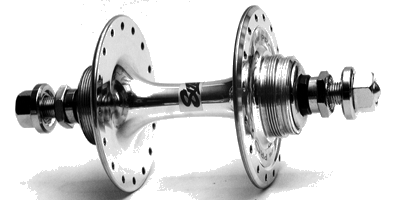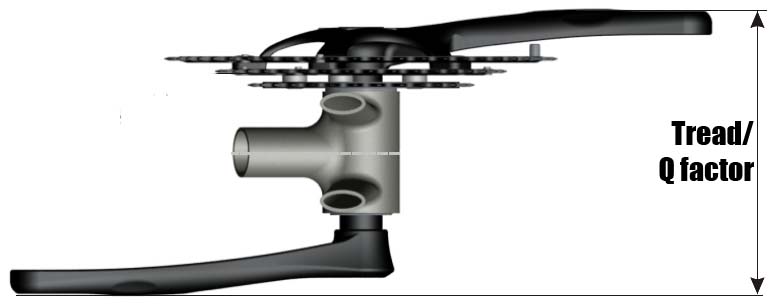Sheldon Brown's
Bicycle Glossary Tp - Tz

|
![]()
| A fixed-gear hub. Track hubs have a stepped thread, with a standard 1.37" x 24 tpi thread for the sprocket, and a smaller, left-hand thread for a locknut. The idea is that if the sprocket should start to unscrew, it will turn the lockring with it, tightening the left-hand thread, preventing the sprocket from unscrewing.
There are several different threads used for the left-threaded lockring, including:
|
 |
|---|

| Track Nuts | Serrated Flange Nuts |
The Guinness Book of World Records once had a category for the slowest bicycle ride, but further entries were disallowed after cyclist Dave Steed held a track stand for 9 hours. It has been reported that he later held one for 24 hours and 6 minutes.
On the banking of the track, which is bankd and where races are run counterclockwise, the front wheel is usually turned to the right. It is possible to do a track stand on a freewheel-equipped bicycle if the front wheel is pointed up a sloping section of road -- so, on a crowned road in right-side driving countries, the front wheel is turned to the left. The technique must be learned separately each way.
A cyclist who has learned both ways can ride a fixed-gear bicycle backwards, switching between a right-side track stand and a left-side track stand. The great Major Taylor once won a match sprint race in this way, by backpedaling a half turn to get behind the other racer for the final sprint to the finish. Following this, the tactic was banned, though track stands are still permitted in match sprints.
[This section expanded by John Allen.]
![]()
![]()
The traction of a tire is affected by:
Joshua Putnam has a good discussion of trail and Bicycle Steering Geometry in general on his Web site.
 Travel Agent ®
Travel Agent ® See the Brake Lever Types entry for more details on this issue.
The cable from the lever normally goes around the small step of the pulley first, then through a hole onto the large step. This causes the cable leaving the Travel Agent to be pulled twice as far (but half as hard) as where it enters. It can also be used in the opposite direction if desired. (Q.B.P. Photo)
Note: the small-diameter pulley will fatigue the cable, resulting in fraying and failure, sooner or later.
![]()
![]()
A wider "tread" also creates a greater sideways force when pedaling out of the saddle, so the rider must exert more upper-body strength when riding "en danceuse".
A wider "tread" decreases pedal-ground clearance when the bicycle is banked over into a tight turn.
("Tread" in this sense is sometimes referred to as "Q-factor.")

Another way of looking at it is that a trekking bike (or a hybrid for that matter) is basically a touring bike with upright handlebars instead of drops.
Although the word "trek" is of Afrikaans origin, meaning a long painful journey on foot or by oxcart, I believe the term "trekking" bike originated in Germany in the 1980s.
Trials are sometimes done on more-or-less standard mountain bikes, but more often with purpose-built trials bikes.
A trials bike is a one speed, geared very low, with a tiny chainwheel both for low gearing and improved clearance. Tires are usually fat 20" or 24" size, with aggressive tread. Frames are small, equipped with a very low saddle. Trials riders never actually sit on the saddle, but a saddle is required as a safety measure.
The major technique involves locking the wheels up with the brakes, and bouncing the bike up and down in the manner of a pogo stick. In this way it is possible to climb stairs sideways, etc.
The cycling section of a triathlon is run as if it were a time trial. Drafting is forbidden, so there can be no team tactics or other assistance between contestants.
The popularity of triathlons has brought many new participants to cycling, and because these participants are highly motivated but not in touch with many of the hidebound traditions of cycle racing, triathletes have introduced many fresh designs to cycling, most notably the æro handlebar.
 Because of the lack of team tactics, and the tendency to use fairly flat courses for the cycling leg of triathlons, all sorts of ærodynamic parts and accessories have become popular among triathletes. This is helped by the fact that triathlons arenot governed by the U.C.I. and there are very few restrictions on allowable equipment.
Because of the lack of team tactics, and the tendency to use fairly flat courses for the cycling leg of triathlons, all sorts of ærodynamic parts and accessories have become popular among triathletes. This is helped by the fact that triathlons arenot governed by the U.C.I. and there are very few restrictions on allowable equipment.
![]()
![]()
Some indexed front shift controls provide a "trim" function, usually an extra click or two, to let the rider compensate for this.
In the early 1980s, Sun Tour used to make a special shift lever , the "Symmetric", that automatically adjusted the position of the front lever as the rear was shifted, to automate the trimming process. This system turned out to be very troublesome, and was abandoned after a single season.
Modern front derailers are designed around specific chainwheel combinations so that trimming is un-necessary in most cases if the front derailer is properly adjusted. (See my article on Derailer Adjustment.)
This term is sometimes used incorrectly to refer to a triplet, a 3-place tandem.
A wheel which is "out of true" vertically will be out of round, and will give a bumpy ride even on a smooth road. If it has splayed sidewalls, it will also cause pulsation of a rim brake.
A wheel which is "out of true" horizontally may rub on the brake shoes at part of its revolution, causing excessive drag...or causing the brake to be adjusted looser than it should be to prevent this drag.
"Truing" is the act of making a wheel run true. This procedure is described in my Wheelbuilding Article.
The purpose of the tube is to make the tire airtight. The tire itself may have small holes and pores without creating a problem, as long as the tube doesn't leak. If the tire has a large hole or cut, the stretchy rubber tube can bulge through and burst. The tube does not, in itself, have the ability to withstand the high pressures used in bicycle tires without the support of a tire around it.
Andy tube will slowly lose pressure as air seeps out through the rubber. Most tubes are made of synthetic (butyl) rubber. The can usually go a week or more without significant loss of pressure. Some tubes have been made of natural latex rubber, for light weight and more flexibility -- but they need to be pumped up at least once per day.
The oldest material for this is steel of one sort or another. See also chrome-moly, gas pipe, high tension
Some noted brands/models of steel tubing for bicycle use include: Reynolds 531, 753, 853 (England), Vitus (France), Columbus (Italy) Ishiwata and Tange (Japan) and TrueTemper (U.S.A.)
Steel bicycles are built by joining the tubes either with lugs, welding, or fillet brazing. Only welding is used for aluminum or titanium frames.
![]()
![]()
Tubulars use Presta valves.
Most people find expensive tubulars too expensive for recreational riding...but cheap tubulars are distinctly inferior to good clinchers, particularly in that they tend to be lumpy and crooked.
Comparing high-quality tubulars with clinchers, including the rims, tubes, etc, tubulars save about 50 grams per wheel...but your bike winds up heavier, because you really need to carry a complete spare tubular, as opposed to a tube and/or a patch kit. This doesn't apply if the team car is carrying spare wheels/bikes for you.
If you don't glue your tubulars on properly, they can roll off, causing you to crash. If you get a flat on the road, you can't glue your spare securely, since the glue needs to dry overnight; as a result, you have to ride very gingerly on your spare, taking it really easy on the curves and descents. If you get two flats on the same ride, you're screwed.
Some people believe that tubulars corner better in the rain...but I never go fast on wet roads anyway. If you flat in the rain with tubulars, your ride is over, because there's no way to make a wet tubular stick to a wet rim.
Tubulars are fairly immune to "snake-bite" rim cuts, and may offer slightly better "suspension" action than comparable clinchers. Their rolling resistance is actually worse than with good clinchers in most cases, due to imperfect contact of the glued section with the rim, so there is rubbing.
Standard size tubular tires use a rim that corresponds in diameter to a 622 mm (700C) clincher rim.
Back in the 1970s, 622 mm clinchers were very rare in the U.S., and most sporty bikes used either 630 mm (27 inch) clinchers, or standard (622 mm) tubulars.
The fact that these sizes are so close led to an in-accurate habit of referring to "27 inch" tubulars. This careless nomenclature still causes confusion, and people often imagine that there is a different "27 inch" size in tubulars as there is in clinchers.
This is not true. THERE IS ACTUALLY NO SUCH THING AS A "27 INCH" TUBULAR.
All full-size tubulars fit all full-size tubular rims.
There are smaller tubulars, "26 inch", "24 inch" and even smaller, but those are VERY uncommon, mainly used for children's race bikes, which hardly exist at all in the U.S. The smaller sizes are very poorly standardized; tires and rims of nominally the same size may not fit one another.
There are several articles about tubulars in Jobst Brandt's FAQ section:
This size is probably a good option for taller riders for off-road use, compared with 559 mm (26 inch decimal) wheels. Larger-diameter wheels don't sink as far into holes, so they give a better ride in rough conditions.
For shorter riders, wheels this large will cause unfortunate compromises in frame geometry, so they're probably not a good option for riders of short or medium height.
Most crank sets are three-piece, there are also one-piece crank sets.
Shimano revived the two-piece design with the 2004 Dura-Ace "Hollowtech II ® " crank and bottom bracket. These use external-bearing bottom brackets and large-diameter hollow shafts.
This system has "trickled down" the Shimano line in later years, and is gradually replacing three-piece cranks on most better quality bikes. Other manufacturers have also adopted this system, which seems to be becoming the new de facto standard.
![]()
![]()
![]()
Last Updated: by John Allen